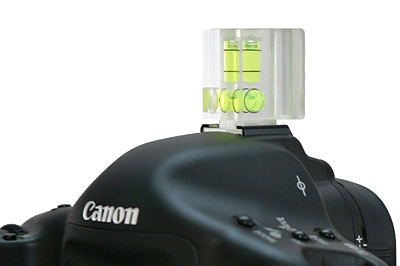Why Bubble Levels Are a Waste of Money
There may be a time and a place for a real bubble level, but I happen to think that it’s in carpentry. I’ll tell you why.

In this day and age, you can buy nearly any piece of photographic equipment with a bubble level built into it somewhere. Tripods, ball heads, camera brackets, and even little standalone levels that clip into your hot shoe like the one shown above (made by Hakuba). Do I think these products are clever? Absolutely. Do I recommend purchasing one? Not really.
If you’re building a house, making sure things are level is pretty important. You probably wouldn’t want to walk uphill from your living room to your kitchen, for example. In photography, however, we’re talking about making art, about expressing emotion, about things far divorced from the mechanics of building robust structures for people to live in.
The bubble level started showing up in photography equipment to help people level their images with the precept that keeping your image level is a good thing. I can’t argue with that; if you have a noticeable horizon line in your image and it isn’t wildly and purposefully off-kilter, it should darn well be horizontal. If it is wildly and purposefully off-kilter, you don’t really need a bubble level to do that.
There are three reasons I believe these bubble levels are useless:
-
Bubble levels integrated into tripods are fundamentally worthless because they only tell you if your tripod is level, and unless you have your camera screwed directly onto your tripod (please, please answer “no” to that), it doesn’t do you much good. A tripod can be very steady and secure without being level.
-
A bubble level on your camera does not guarantee that it is level with the surface of the ground (read: what you see), but rather that it is level gravitationally, which may be different. If you are shooting a horizon line that is actually a subtle hill or other topographical feature, the bubble level may actually make your image appear not to be level.
-
Fundamentally, your final image may appear to be level or not level based on features of the composition, including hills, vertical elements such as trees or man-made structures, and so forth. A bubble level isn’t savvy to composition.
Basically, bubble levels only help you if you’re shooting a water horizon, which positively must be gravitationally level because it’s water, or if you’re shooting a scene where gravitationally level is exactly what you want regardless of any other topographical features, such as wide angles of mountain ranges, deserts, and so on.
For my money, I’d rather adjust the frame by eye than buy a doohickey to do it for me and hope that my situation lends itself to the device’s abilities.
Okay, so, how do you level the frame without a bubble level? Here are a couple of tricks I use:
-
Use your autofocus points. If it’s daytime and you can see your autofocus points, align them with elements in the scene to make sure they’re level. the AF points in your viewfinder are guaranteed to be level with respect to the frame, so it gives you a visual hand-hold for lining up horizons and buildings and everything else.
-
Squint. Seriously. One of the more important habits I’ve picked up over the years is to take stock of the entire frame as a composition, which can be hard to do when your face is pressed up against the camera and you have one eye closed and you’re possibly contorting yourself to lean over to where your tripod is perched. If there is a horizon and a tree that should appear to be horizontal and vertical, respectively, pay careful attention to how they appear to be oriented within the frame as a whole rather than how the horizon or the tree line up with AF points or edges of the frame on their own.
-
Fix it in post-processing. I know, that sounds like a cop out, but it’s your last line of defense. If you’re going to be editing all of your photos anyway (as I’m sure you do), it’s a better investment to tweak the horizon a little in Lightroom than to buy a bubble level and wind up having to tweak it in Lightroom anyway since the horizon wasn’t gravitationally level in the first place.
At the end of the day, having one of those little gizmos is probably a net benefit if you know when to use it and when not to use it. But for my money, I’d rather concern myself with the aesthetics of the composition as it appears through the viewfinder than whether or not my camera is gravitationally level or not.
Edit! I ran into a very congenial gentleman here in the Great Smoky Mountains who was on leave from the Army, preparing for his third tour in Iraq, camping and photographing in the park. He was shooting some panoramas with his D200 and told me that a hot shoe bubble level is essential in that case. Now, I could probably go out on a limb and argue against that point, but instead I will concede that shooting panoramas sounds like a pretty good reason to use a bubble level. One of the few.
 Single-Serving Photo
Single-Serving Photo
Comments